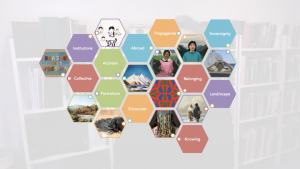Course Plan for Instructors
CanadARThistories contains:
- a course plan for instructors
- a suggested assessment package for instructors
- a sample syllabus
- thematic modules
- contributor-based object essays.
About this course and resources
CanadARThistories, a new online course and its associated open learning objects, addresses growing concerns around inclusion, regionalism, Indigenization, and internationalization in art history curricula, and is conceived as a response to these ideas. The course highlights the rich visual and material culture of this land through a series of entries, written by subject experts, that focus on the artistic contributions of Indigenous and settler makers. It can be further shaped and reshaped to challenge and redistribute the traditional, chronological, and rigid narratives of Canadian art and to encourage learners to be co-constructors of knowledge.
The course supports a second-year undergraduate survey of art in Canada. Through thematic modules, diverse visual traditions and their intersections will be introduced, as will the changing roles of art in society. The thematic modules and suggested assignments will centre learners, engaging them in active learning practices and the creation of new learning objects and resources, while also developing critical and analytical skills central to the field of art histories.
The course is easily customized to the needs of individual instructors and institutions. The modular and flexible design of the course enables it to be adapted to blended and face-to-face learning. This course can be used as a “course in a box” that you can incorporate into your learning management system and use. You might choose to customize it by developing your own module overview videos and videos to explain the assignments. We also encourage you to personalize this content by adding your own graphics and visuals. We have tried to build in flexibility so that you can take bits and pieces that work for you and remix them, as the majority of content is licensed under Creative Commons.
Accessibility
The developers of CanadARThistories are committed to ensuring equal access and participation for people with disabilities as defined by the Accessibility for Ontarians with Disabilities Act (AODA). The web version of this resource has been designed in Pressbooks, which complies with Web Content Accessibility Guidelines (WCAG) 2.0 at the A and AA level. In particular, this resource incorporates the following features:
- content that is accessible to people who use screen-reader technology
- accessible videos—all videos in this recourse have captions
- accessible images—all images in this resource that convey information have alternative text
- accessible links—all links use descriptive link text
- information is not conveyed by colour alone.
If you have problems accessing this resource, please contact the project coordinators (openarthistories@gmail.com) so we can address the issue. Please include the following information:
- the name of the resource
- the location of the problem (provide a web address or page description)
- a description of the problem
- the name of the computer, software, browser, and any assistive technology you are using that might help us diagnose and solve the issue.
License
CanadaARThistories is licensed under a Creative Commons Attribution-NonCommercial-ShareAlike 4.0 International License, except where otherwise noted.
Every effort has been made to trace the copyright holders and obtain permission to reproduce the images within this work. If you have questions about the use of images within this work, or are a rights holder who would like an image removed, please contact the project coordinators (openarthistories@gmail.com).
Online and in-person adaptations
Asynchronous online courses: Modules can take the place of lecture, in-class activities, and assigned readings.
In-person or blended courses: Modules can be assigned as reading for an in-person or blended course, and the learning journal activities used as active learning components in a flipped classroom. Alternatively, instructors may wish to use the modules as outlines for in-person lectures and assign one or two learning journal activities as in-class, active learning. Assigned readings can be drawn from the object essays.


